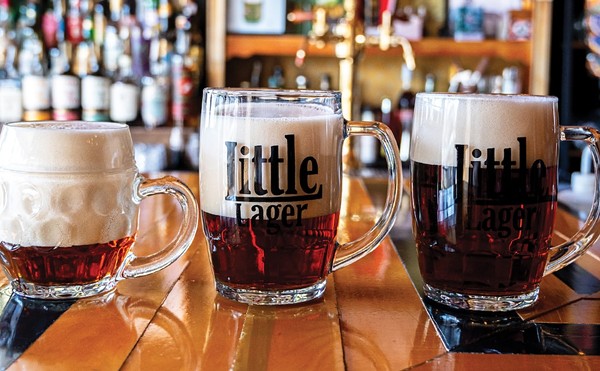But even I have my limits. Take osso buco. In Italian, literally, bone hole. Braised veal shank, served bone-in, the bone itself filled with luxuriant marrow to be spread on toast or the veal or whatever's handy. Your finger's fine. I won't tell.
Should osso buco be topped with a gremolata, a mix of garlic, parsley and lemon peel? Ideally, but hey, I'm easy! Should osso buco come with a special marrow spoon? Again, ideally, but your butter knife will do. Is the bone actually necessary?
Is the bone actually necessary? The question is ridiculous, I know, yet that was what I asked myself after I ordered osso buco at Mia Rosa. Here osso buco isn't a hunk of veal shank; it's two small veal medallions in a thick brown sauce. No bone, no marrow.
How do you end up with boneless osso buco? If you consider Mia Rosa's menu as a whole, it isn't that much of a stretch. The restaurant specializes in cicchetti — essentially the Italian equivalent of tapas. In Spain and Italy, that means bar snacks. At Mia Rosa, as at many "tapas" and small-plate restaurants in the States, more often than not, that means smaller portions of traditional entrées.
Mia Rosa opened in August, the newest restaurant in the commercial stretch of Forest Park Southeast known as the Grove. Like many of the Grove's new eateries, Mia Rosa can't help but stand out, light spilling from its large windows onto an otherwise dreary intersection a couple of blocks west of Kingshighway. The interior is lovely: wood floors, soft lighting, earth-tone walls offset by brightly colored artwork. Knowing nothing about Mia Rosa, you might, based on looks alone, expect a more formal dining experience. Only the butcher paper on which each table setting rests suggests its casual small-plate approach.
Those small plates are divided between hot and cold cicchetti. There are also antipasto dishes (though how these differ from cicchetti seems a matter of semantics), as well as a raw bar and a selection of soups, salads and (increasingly unavoidable) flatbread pizzas. The executive chef and owner is Philip Noe, whose résumé includes the recently departed Blue Water Grill seafood restaurant. Noe describes Mia Rosa's cuisine as "rustic coastal Italian."
("Which coast?" cracks the wag at the back of the room.)
At any rate, there is seafood: oysters on the raw bar, steamed mussels and a few cicchetti, including my favorite of the restaurant's dishes, monkfish wrapped in prosciutto. The pairing is simple and tasty, the crisp, salty ham the ideal counterpoint to the monkfish's succulent sweetness. Three scallop-size slices of monkfish sit atop basil-flavored fregola, a pasta that's about the same size and shape as couscous.
I also liked another straightforward dish from among the hot cicchetti: braised duck in an Amarone-wine sauce served over polenta. Each of the three duck-breast slices featured tender meat and a strip of crisp, browned skin. The sauce deepened the meat's rich flavor with hints of fruit and spice, and the polenta, heavily seasoned with black pepper, provided a kick.
Neither dish was a revelation, but each showcased distinctive ingredients with relatively minimal interference. Unfortunately, the rest of what I ordered failed to live up to this promising standard. The osso buco, for example, swamped the two medallions with an unctuous and largely flavorless brown sauce. A similar sauce overwhelmed the beef braciole, turning what should have been an interplay of tastes and textures among thinly sliced steak, sharp salami and nutty, melted fontina cheese into a dish reminiscent of Salisbury steak.
Blunt flavors were a recurring problem. An eggplant caponata, one of the cold cicchetti, needed something to contrast the eggplant's acidity. Grilled polenta verde, an antipasto, was a puck of basil-flavored polenta. Neither dish was bad, merely boring. Faring better was the bruschetta; on the day I ordered it, the topping was a medley of wild mushrooms. This made for a pleasing starter and would have been an excellent snack with a glass of red wine. Still, it didn't seem distinctive enough to merit a spot next to other, more entrée-like hot cicchetti.
Other items suffered from evident neglect. Cream of asparagus soup arrived with a visible skin on its surface and was barely above room temperature. The flatbread pizza I tried was lukewarm, its cheese congealing, its crumbles of salsiccia having taken on an unpleasant, gritty texture.
The wine list is relatively short, with most bottles falling into the $30-to-$50 range; a few selections are available by the glass or the quartino. The bar needs to keep better track of these wines: We had to wait quite a while for a bottle of wine on a Saturday night when our server had to check whether our first and then our second choices had sold out.
Like the hot cicchetti, desserts are miniaturized versions of familiar Italian specialties. At $3 each, items like tiramisu and panna cotta are a good value — satisfying, if not world-beating. The panna cotta, like a custard but set with gelatin, was firm but retained its creamy essence; it was spiced like a pumpkin pie and drizzled with a lovely blueberry coulis. The tiramisu boasted its usual charms, though the presentation was off-putting: To fit the smaller serving size, the dessert was more jumbled together than delicately layered.
While I can't really complain about a $3 dessert, the tiramisu seemed emblematic of the larger tension underlying Mia Rosa. The concept of cicchetti is a clever way to stand out in St. Louis's crowded sky of Italian restaurants. The challenge is to use that format to give diners a chance to try dishes that are unfamiliar or innovative or playful, rather than simply shrunk. Could you capture the essence of, say, osso buco in two or three bites? Traditionalists might scoff, but some of us would be more than willing to try.





